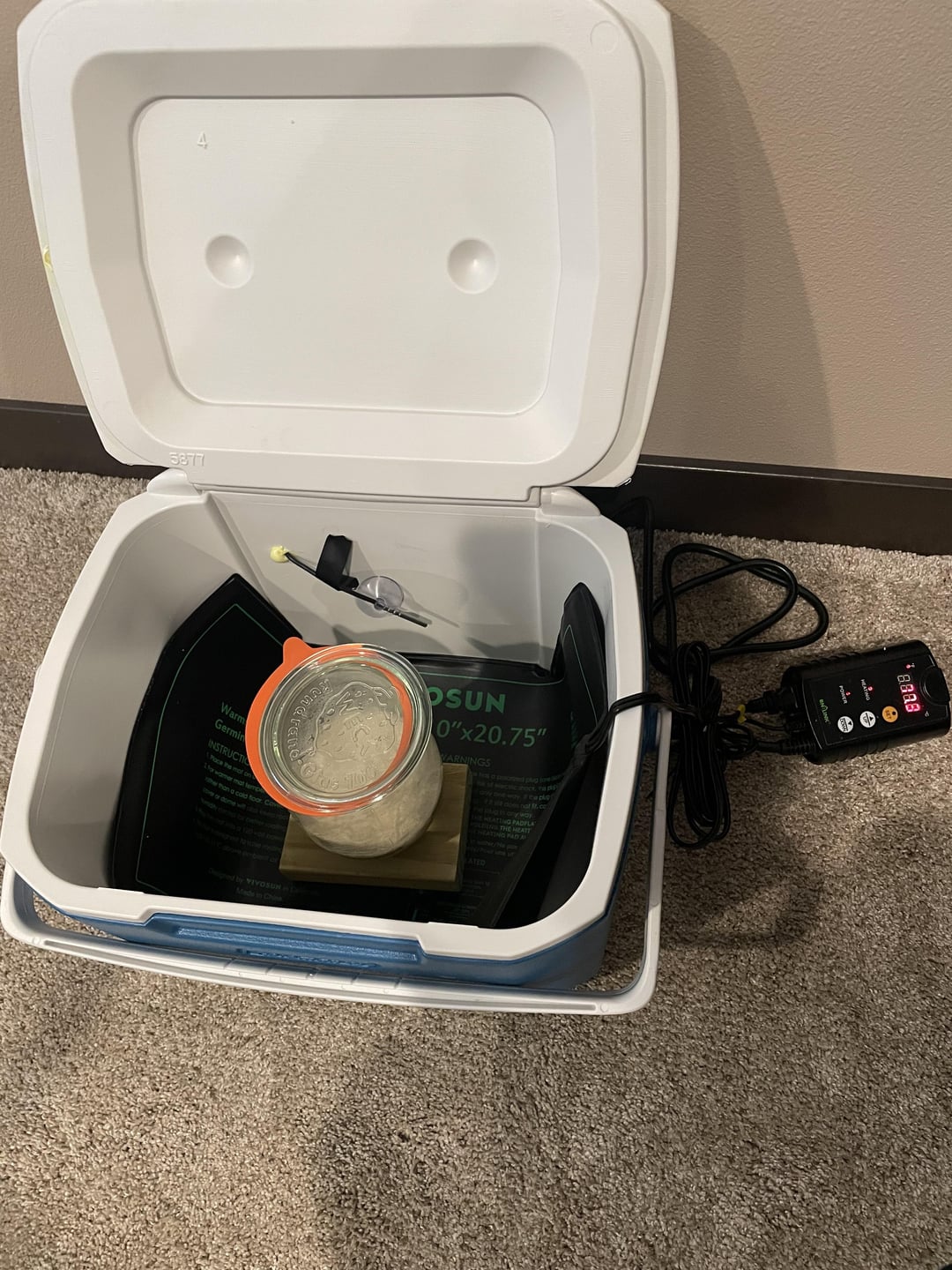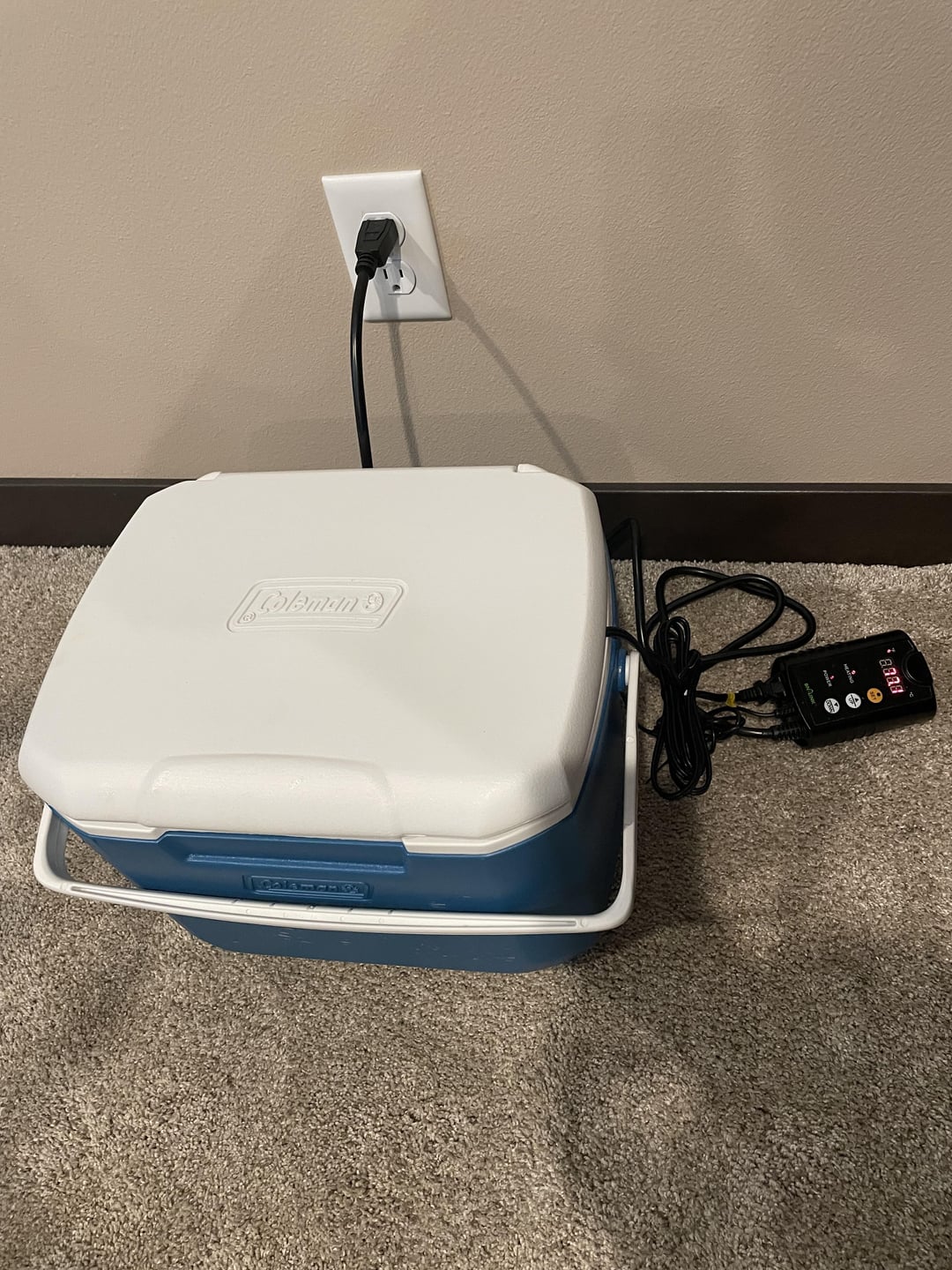

I know it’s not as nice as the $300 proofing boxes you can buy online, but it does the job and he made it himself! Our house doesn’t have any great warm spots and I was having a hard time getting my starter to ferment and rise. The one loaf I did make was extremely underproofed. I’m excited to try this! I’m following the recipe from the perfect loaf book.
by originalgoddessog

22 Comments
**Hello originalgoddessog,**
#**This bot comment appears on all posts.**
***
**[Rule 5](https://www.reddit.com/r/Sourdough/wiki/sourdoughrules/) requires all sourdough photos to be accompanied by the ingredients used & process (the steps followed to make your bake). The details can be included in a picture, typed text or weblink.** **Not all posts require a photo alongside your query, but please add details in your post, so we can help.** **Posts may be removed at any time, but you will be notified.**
***
#**Being polite & respectful**
**are both extremely important in our community.** **[Read rule 1 in detail](https://www.reddit.com/r/Sourdough/wiki/sourdoughrules/).**
**Please be respectful, kind, patient & helpful to posters of all skill & knowledge levels and report offending comments/posters, or [drop us a modmail](https://www.reddit.com/message/compose?to=/r/Sourdough).**
***
**Thank you** 🙂
#**[Overproofed or underproofed?](https://www.reddit.com/r/Sourdough/wiki/reading_crumb/)**
***
#**[NEW Beginner starter FAQ guide](https://www.reddit.com/r/Sourdough/s/gnqFg7osBO)**
*I am a bot, and this action was performed automatically. Please [contact the moderators of this subreddit](/message/compose/?to=/r/Sourdough) if you have any questions or concerns.*
were you not using warmer water when making your starter before this box?
How cold is your house? It’s unlikely it was so cold you couldn’t make a starter. What were your ingredients? What was your process? When did you give up?
Yay for boyfriend! 😉
Haha I do this for a proofing box! Almost exact setup! My house never gets above 64° so it helps massively
I just made one of these myself. I let my house get pretty cold in the winter (I live in the northeast US and so far haven’t turned the heat on). It’s not unusual for my home to be in the 50s when I wake up in the morning, and sometimes it doesn’t go above 60 all day. Climate control for my sourdough has been essential.
Now only if I knew what parts were essential and could dial it in… lol
How do ppl fail a starter… it’s easy to make. You have to discard until it’s ready… you probably just under feed it
Nice! You can also get a cooler like that or plastic tub and aquarium heater. Fill with water so the jar will be partly submerged and you’re good to go!
I’m making one of these, too!
I do this for kombucha. nice.
🤣🤣 I just put a seedling warmer under my starter to get it to rise! It’s cold here and I figured it wouldn’t hurt.
I make sourdough in Alaska. Ironically, it’s easier during the winter because I have a nice warm toyo stove to set my starter on. in summer I have to finish it in my oven proofer because it doesn’t get warm enough in summer, but too warm to turn the Toyo on.
I’ve been thinking of making something exactly like this myself. good job.
https://preview.redd.it/ft2df77cnixd1.jpeg?width=3024&format=pjpg&auto=webp&s=b7ec2377fa1dec8425a95a835959dfe09a0e80c3
This is mine. Plastic bin with seedling mat. I also used the inside of a goodfood box as the insulation. It’s been working great.
Just use warmer water.
You failed twice at creating a starter? This has me worried because I just started a starter from scratch on the 23rd.
Hopefully 🤞 everything works for us both. I’d hate to waste all that time and flour. Even if it’s cheap.
Good luck. Make sure the temperature doesn’t get too high. I see that heater has a temperature control on it so that’s great and probably a non issue with that one.
This is perfect. I built the same for kombucha, but started using it for dough as well.
Sometimes if I need a warmer spot I microwave some water for a minute or two and then put my dough in there.
Nicely done!! Your starter will come along nicely in 75-80°F environment (optimum temperature for beginning a starter).
I made one starter in 66-68°F temps and it took ever so long to let me know it was really alive, lots of patience required. I’ve been in experimenting mode the last two years, so I knew I could do it differently, but wanted to see if it was possible to do a cool room starter. I might do it again and take photos/put together instructions because a lot of us have cooler homes and I think all the guides pretending a starter is normally ready in 5-7 days are completely unrealistic. They make people think they have failed and they give up. It is almost always a 2 week process at a minimum.
My cold temperature starter is not quite a year old, but its behavior is puzzling me a little bit. I used it for dough yesterday and intentionally put it in a room that was 64-65°F overnight because I wanted a slow bulk ferment (dough temp was 67°F when it went into the cool room). The silly thing more than doubled overnight and lifted the lids on the cambros.
Eeeesh!! I think I will need to re-name it to something wintery like Snow Queen, because it seems to thrive in the cold.
I will have to do another test with my warm weather starter now to see if it is also doing this, or if it is unique to the winter cool temp created starter.
I have to reinvent many ways of working since I moved into an antique home that does not have central heating 😂
I just stick mine in the microwave with the door cracked open so the light stays on and that’s seemed to work for me
You can park your starter on top of the refrigerator next to the door opening and the anti-frost heating will keep it warmer in a cooler kitcher.
I found that following any kind of recipie for the starter didn’t work for me. At least for how long you should be feeding it and stuff. And it’s a lot of trial and error.
I started my starter in june and fed it every 24 four hours around 6 week before I even atempted a loaf (the recipie said 7-14 days). I live in norway and we had a crap summer, so the tempetures weren’t ideal, but i just kept going even tho it didn’t look like it was working and eventually it just worked.
Now I’m keeping it in the fridge until the day before I want to use and feed it in the morning, then make a leaven 12 hours later, then another 12 before i can start mixing and shaping the dough and it works great. I just keep it in the microwave and when I need to start fermenting the dough I switch it to the oven (our oven has a rise function that keeps the oven on 40 degrees celcius).
I only just started getting good loaves tho, like maybe a two months ago. I originally used the recipie from the same website i got the starter recipie from and it didn’t work. That recipie took three days from feeding to finished loaf.
Then I switched, also took three days and that didn’t work either.
I switched again and I finally got it to work and it’s only two days. The last few I’ve made I’ve even started adding flavors in (cheddar and bacon) and it’s great!
So if you find that the starter isn’t doing anything for a while just keep feeding it every day and you’ll eventually see that it’ll be ready. And if the loaves you try baking doesn’t work try switching to another recipie and see if that works better. Like I said, it’s a lot of trial and error, but with patience it will work out.
Hi. Some interesting comments here. That’s a very handy DIY proofing box you now have for both starter and small batches of dough.
There are ways to avoid the difficulties of the battle of the bacteria. However if you are following the flour and water route:
There are several phases to developing your starter.
In the first there is a rapid reaction as bacteria fight for supreacy create a false fermentation. That finally subsides and creates a more acidic environment that suits yeast and ‘good’ bacteria better. It needs feeding once a day.
In the next phase the activity is useually not evident but the culture goes flat and more liquid. Things are still happening in the murky depths so it still needs feeding daily.
In the last phase the character of your starter will change becoming a creamy unctious texture with small bubbles evident. The yeast cells are multiplying abd devloping CO2. With repeat feeds the fermentation will become stronger. However different flours will have different rise. Whole grain flours, thp high in nutrients and yeast will typically rise less than ordinary flour because of the bran content that inhibits the ferment and creates a coarse fibrous matrix that allows gas to escape. For this reason most yeast starters will have a high, strong white bread flour content. In the early stages of this phase feed twice daily. Start to note how long it takes to double, triple and peak. For this is the way you gauge the vigour of your starter.
To start your culture all you need is a jam jar complete with lid, digital scales, flour, tepid water and a spatula to mix and scrape down jar. Just mix 15g of your chosen bread flour mix with 15 g water in a clean jam jar with screw down lid. Mix till smooth paste, scrape down jar, mark level and screw lid on loosely. Rest in warm place 75 – 80°F 24 hours.
Feed her, thoroughly mix , reduce to 15g and feed 1:1:1 preferably with a flour mix of 80% strong white bread flour and 20 % whole wheat or rye. Mark level scrape down inside of jar. Replace lid and allow to ferment on counter. Follow phases but maintain regular daily feed or when fallen whichever is the soonest Note time it takes to double, triple and peak (starts to fall). Repeat feed when falling or at 12 hrs. Once she is doubling in around 4 hrs you’re good to go.
I keep 45 g in the fridge. When I want to bake I pull it out let it warm up before feeding it 1:1:1 this gives me my levain and 15g surplus to feed 1:1:1 to become my new starter. It lives in the fridge till needed.
Happy baking